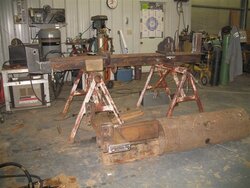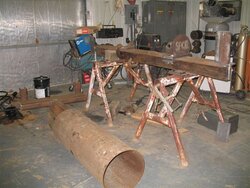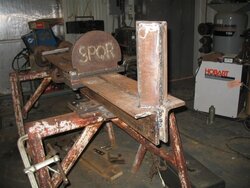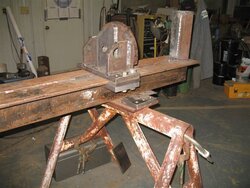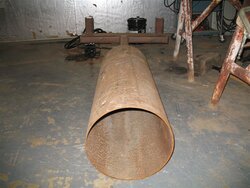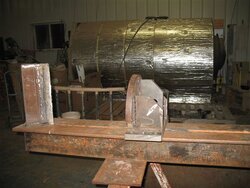the pics will be coming shortly.
for now, here is a description.
the beam's made from two angles that are 5/8" thick x 4" x 6" x 94" long.
I positioned the angle such that the 6" is vertical and the 4" are used for
the horizontals.
there is a 1" space between them to allow for welding the wedge and
cylinder anchors. (see pic 2342)
the opposite end where the 5 x 36 cylinder will be mounted (it's not welded
in yet, just has a clamp holding it) will also be welded between the two
angles. (see pic 2340)
every 18" along the beam and between the two angles, I welded a 1" thick x
2" wide x 6" deep piece of stock to help stiffen it up. it's kind of hard
to see from the pics.
pics 2340 and 2341 shows the 3 point and the hydraulic tank pipe.
the hydraulic tank is a 1/4" thick x 16" dia pipe x 48" long. (see pic
2344)
I will be using a L4400 Kubota's PTO to run a 22 GPM pump.
questions I have are:
1) can I weld the bottom of the beam to the top of the 3 point and pipe?
2) when splitting a chunk of 30" long elm, will the beam have too much
twist and pull the welds form the tank and beam?
3) do I need to weld a plate, say 5/8" or 3/4" thick x 8" wide x the length
of the beam on the bottom and then weld the tank to that plate, or will the
tank be strong enough without the added plate?
4) referring to pics 2343 and 2345, is the wedge and push plate strong
enough?
the wedge is made of 1" thick x 6" wide x 18" long (6" of this is between
the two angles).
I then beveled, hard faced and reground the point.
two angles 3/8" x 3" x 3" x 12" were welded on both sides of the wedge to
strengthen the wedge and help separate the wood while splitting.
the push plate is mostly 1" thick material.
5) I think I may have already drilled the hole for the cylinder on the push block mount too high.
it measures 5" off of the top of the beam. when I mount the cylinder on to the puch block, there will be a 2" gap between the bottom of the cylinder and the top of the beam.
the farther the cylinder is mounted off of the beam, the more twist I will have ... correct?
do you think it will be ok, or do I have to cut the push block apart and reposition the hole so I only have... say 1/2" of space between the bottom of the cylinder and the top of the beam?
I hope you can help me out so I don't have to do too much rework.
thanks,
topo
for now, here is a description.
the beam's made from two angles that are 5/8" thick x 4" x 6" x 94" long.
I positioned the angle such that the 6" is vertical and the 4" are used for
the horizontals.
there is a 1" space between them to allow for welding the wedge and
cylinder anchors. (see pic 2342)
the opposite end where the 5 x 36 cylinder will be mounted (it's not welded
in yet, just has a clamp holding it) will also be welded between the two
angles. (see pic 2340)
every 18" along the beam and between the two angles, I welded a 1" thick x
2" wide x 6" deep piece of stock to help stiffen it up. it's kind of hard
to see from the pics.
pics 2340 and 2341 shows the 3 point and the hydraulic tank pipe.
the hydraulic tank is a 1/4" thick x 16" dia pipe x 48" long. (see pic
2344)
I will be using a L4400 Kubota's PTO to run a 22 GPM pump.
questions I have are:
1) can I weld the bottom of the beam to the top of the 3 point and pipe?
2) when splitting a chunk of 30" long elm, will the beam have too much
twist and pull the welds form the tank and beam?
3) do I need to weld a plate, say 5/8" or 3/4" thick x 8" wide x the length
of the beam on the bottom and then weld the tank to that plate, or will the
tank be strong enough without the added plate?
4) referring to pics 2343 and 2345, is the wedge and push plate strong
enough?
the wedge is made of 1" thick x 6" wide x 18" long (6" of this is between
the two angles).
I then beveled, hard faced and reground the point.
two angles 3/8" x 3" x 3" x 12" were welded on both sides of the wedge to
strengthen the wedge and help separate the wood while splitting.
the push plate is mostly 1" thick material.
5) I think I may have already drilled the hole for the cylinder on the push block mount too high.
it measures 5" off of the top of the beam. when I mount the cylinder on to the puch block, there will be a 2" gap between the bottom of the cylinder and the top of the beam.
the farther the cylinder is mounted off of the beam, the more twist I will have ... correct?
do you think it will be ok, or do I have to cut the push block apart and reposition the hole so I only have... say 1/2" of space between the bottom of the cylinder and the top of the beam?
I hope you can help me out so I don't have to do too much rework.
thanks,
topo


